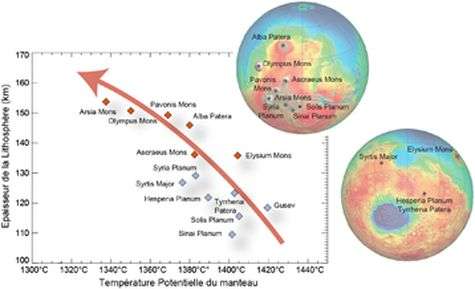April 7, 2011 report
Chemistry on Mars reveals cooling rate

(PhysOrg.com) -- French researchers from the University of Toulouse have published a paper in Nature, that describes how they used data from NASA's Mars Odyssey (currently orbiting the planet) to ascertain the amount of cooling that Mars has undergone over billions of years. Their work is part of an ongoing international process to reconstruct the geologic history of the Red Planet.
By studying thorium, silicon and iron concentrations in the Martian soil (based on the Gamma Ray Spectrometer data collected from onboard the Odyssey) David Baratoux, Michael Toplis and their colleagues have been able to deduce that Mars has cooled by about 80°C (176°F) over the past two or three billion years, which some have noted is slower than that for Earth.
The researchers focused on twelve different volcanic plains on the Martian surface, each of a different age. Thorium, a radioactive element was chosen as one of the study agents due to the fact that when it’s heated it doesn’t get locked in with other elements, which makes it a good source of information for mantle temperatures when it is transported to the surface via volcanic activity (plus the fact that it continually emits gamma rays). Studying silicon in the volcanic soil, on the other hand, helps to gauge melting depth; and iron can be used to help figure out how accurate the first two are.
The researchers were able to come to these conclusions because it is already well understood that the composition of magma pushed to the surface through melting of mantle rocks (creating volcanoes) is controlled by depth, temperature and pressure exerted before being forced to the surface. With data from the GRS they were able to measure the composition percentages of the studied elements and the degree of variation between them, and also to calculate the degree of melting; to which they were able to apply mathematical modeling that gave them the pace of cooling.
In addition to coming up with a reasonable estimate of planet cooling, the team also came up with evidence to suggest that Mar’s lithosphere is thickening.
By studying changing temperature patterns on Mars, and other planets, researchers hope to gain new insights into how our own planet might behave as the future unfolds.
More information: David Baratoux et al., Thermal history of Mars inferred from orbital geochemistry of volcanic provinces, Nature (2011) doi:10.1038/nature09903
© 2010 PhysOrg.com



















